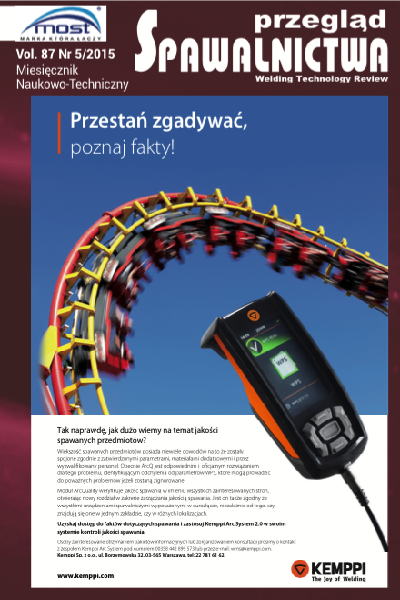Ocena skłonności do pękania gorącego stali 304H
Main Article Content
Abstract
Określenie skłonności do pękania spoin ze stali 304H jest istotne dla opracowania technologii spawania i napawania stali. Pęknięcia gorące powstają w odlewach, spoinie i strefie wpływu ciepła, w pewnym zakresie temperatury, zwanym zakresem kruchości wysokotemperaturowej (ZKW). W pracy podjęto badania, które obejmowały: ustalenie temperatury likwidus i solidus, wyznaczenie temperatury utraty wytrzymałości NST (Nil-Strength. Temperature), temperatury utraty plastyczności NDT (Nil-DuctilityTemperature) i temperatury odzyskania plastyczności DRT (Ductility. Recovery. Temperature). Uzyskane wyniki umożliwiły określenie zakresu kruchości wysokotemperaturowej dla stali 304H. Przeprowadzono również badania metalograficzne i fraktograficzne, które pozwoliły na poznanie mechanizmu powstawania pęknięć gorących w stali. Na tej podstawie opracowano technologię łączenia doczołowego spawanych rur ożebrowanych zapewniającą spełnienie wymagań klasy B zgodnie z PN-EN ISO 5817.
Evaluation of susceptibility to hot cracking of steel 304H
Abstract
Defining the susceptibility to hot cracking of steel 304H magnesium alloy welds is essential for elaborating welding and pad welding technology. Hot cracks arise in casts, weld and heat affected zone, in certain range of temperatures, called Brittle Temperature Range (BTR). This paper contains research covering: defining liquidus and solidus temperatures, determining Nil- Strength Temperature (NST), Nil-Ductility Temperature (NDT) and Ductility Recovery Temperature (DRT). Acquired results enabled to define Brittle Temperature Range of steel 304H. There have been also conducted metallographic and fractographic research, which enabled to get to know the mechanism of hot cracks arising in this steel. Based on results, technology of butt welding of finned tubes that meet the requirements of class B specified in PN-EN ISO 5817 was worked out.
Downloads
Article Details
Creative Commons CC BY 4.0 https://creativecommons.org/licenses/by/4.0/
Welding Technology Review (WTR) articles are published open access under a CC BY licence (Creative Commons Attribution 4.0 International licence). The CC BY licence is the most open licence available and considered the industry 'gold standard' for open access; it is also preferred by many funders. This licence allows readers to copy and redistribute the material in any medium or format, and to alter, transform, or build upon the material, including for commercial use, providing the original author is credited.
References
Kocurek R., Adamiec J.: Manufacturing technologies
Adamiec J.,Więcek M.,KokotG.:Technologia spawania laserowego rur ożebrowanych, Przegląd Spawalnictwa 5/2014.
Tasak E.: Metalurgia spawania, Wydawnictwo JAK, Kraków 2008.
Adamiec P., Dziubiński J., Gruszczyk A. i in.: Metalurgia spawania, Wyd. Pol.Śl., Gliwice, 1992.
Gleeble 3800 Aplications, Welding Process Simulation 2000.
Butnicki S.: Spawalność i kruchość stali, WNT, Warszawa, 1979.
